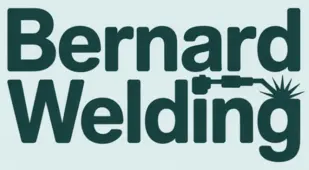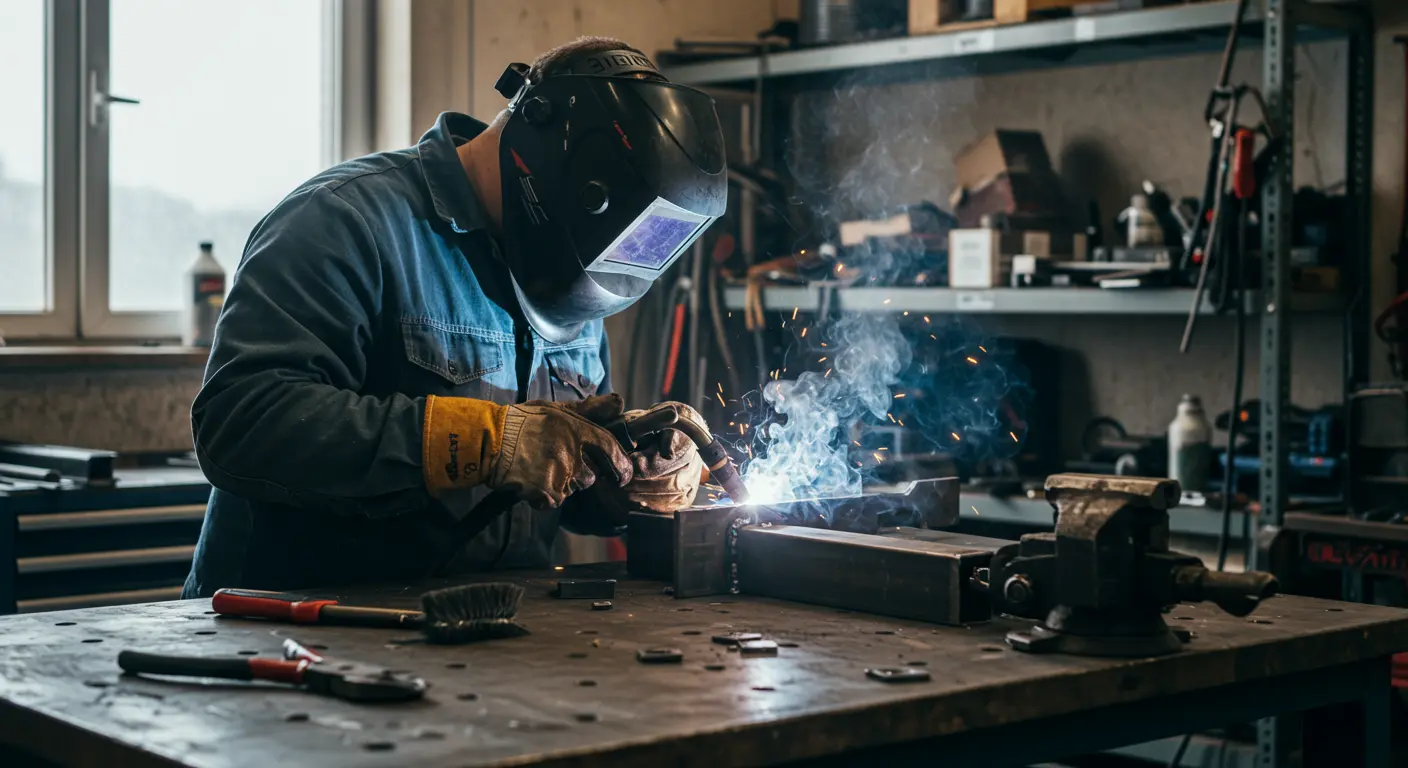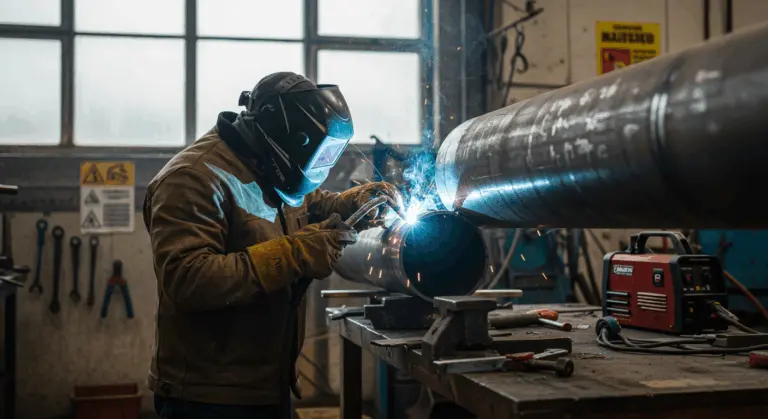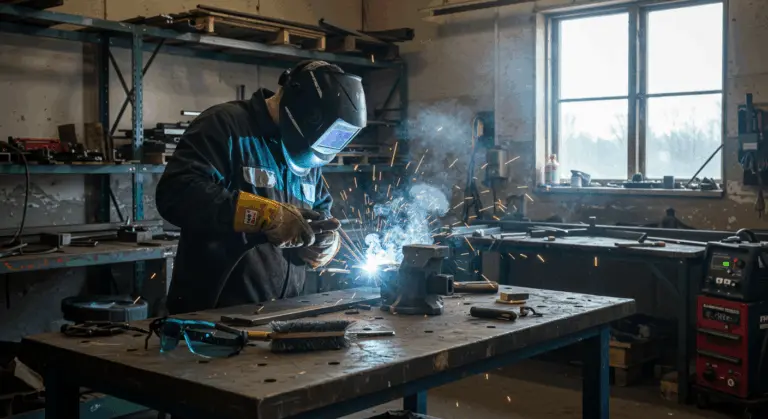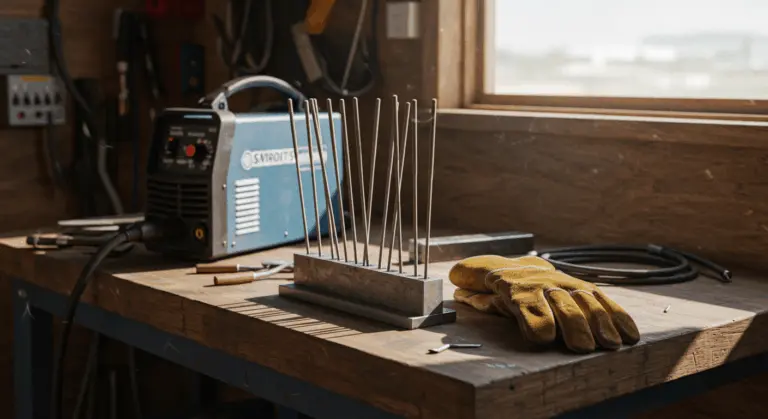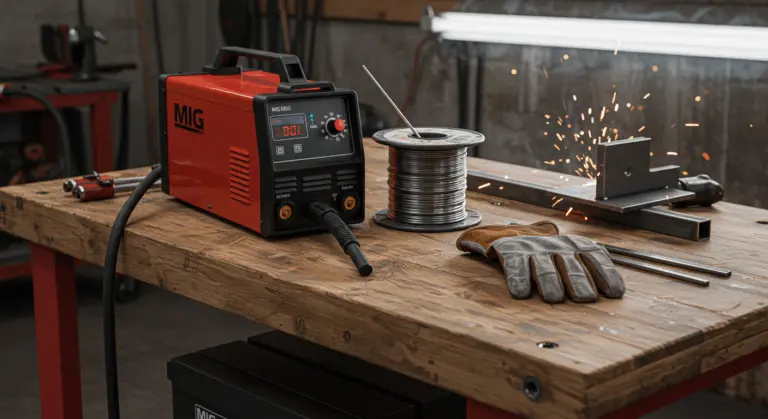What are MIG Welding Weave Patterns?
MIG welding weave patterns represent deliberate, rhythmic torch movements that control a weld’s fundamental characteristics—its contour, dimensions, penetration depth, and thermal distribution across the joint.
The most common patterns, each with specific applications, are:
Beyond their functional purpose, well-executed weaves create uniform, visually striking beads while preventing critical defects like undercut and slag entrapment—flaws that can compromise joint integrity.
Common Types of MIG Welding Weave Patterns
Stringer Bead – The Basics
The stringer bead serves as welding’s fundamental building block. This technique demands steady forward torch movement along a precise straight line, avoiding any side-to-side oscillation while maintaining unwavering consistency in travel speed, angle, and standoff distance.
This approach yields remarkably uniform, arrow-straight beads with minimal heat distortion and mirror-smooth finishes. Stringer beads are characterized by their narrow width and consistent appearance, making them ideal for root passes and applications where precision is crucial. Their simple design allows for faster travel speeds than complex weave patterns—a productivity advantage that experienced welders use regularly.
Yet stringer beads aren’t without constraints. Their penetration capabilities are less than certain weave patterns, and they struggle to bridge substantial gaps between workpieces effectively. In practice, welders often use stringer beads for root passes and then switch to weave patterns for fill and cap passes to ensure proper fusion and coverage.
Mastering stringer beads hinges on achieving precise 50% overlap between adjacent passes while maintaining meticulous slag removal between each layer. This approach builds the foundation for bead control that will serve you well as you advance to more complex weaving techniques.
Zigzag Weave – Balancing Ease and Quality
The zigzag weave is one of welding’s most versatile techniques, prized for its elegant balance between accessibility and performance. This side-to-side torch movement proves indispensable for wider joints where a simple stringer bead falls short.
The zigzag’s oscillating motion ensures superior fusion while distributing thermal energy more uniformly—a characteristic that reduces troublesome defects like undercut, particularly during challenging vertical welding operations.
Executing an effective zigzag demands strategic timing: pause deliberately at each edge while maintaining fluid motion through the pattern’s center. These calculated hesitations allow the molten pool to thoroughly wet the joint’s edges, ensuring complete metallurgical bonding. Without these pauses, you risk creating a weld with excessive buildup in the middle and poor tie-in at the edges.
With moderate complexity, the zigzag pattern sits comfortably within reach of intermediate welders seeking to expand their repertoire. It’s particularly effective for structural steel applications and thicker materials where its ability to fill larger gaps and distribute heat evenly results in strong, reliable welds.
Circular Weave – Advanced Techniques
The circular weave represents a sophisticated technique involving continuous, looping torch movements that give welders excellent control over weld pool behavior, heat input precision, and penetration control.
This pattern’s adaptability lies in radius manipulation—tighter circles drive deeper penetration for structural applications, while broader loops deliver extensive coverage for surfacing work.
The continuous circular motion helps control, containing and directing the weld pool—very helpful when working against gravity in vertical or overhead positions. The continuous movement helps prevent the molten metal from sagging or dripping while ensuring thorough fusion.
Mastering this technique requires more practice than straightforward methods like stringer beads or basic zigzag patterns. Focus on maintaining consistent circle size and travel speed to achieve uniform weld beads. With practice, the circular weave becomes an invaluable technique in your welding arsenal, particularly for pipe welding and applications requiring precise control over weld bead appearance and properties.
J-Weave – Extending the Whipping Technique
The J-weave emerges as a specialized evolution of the whipping technique, delivering enhanced precision for demanding scenarios like open root joints where conventional patterns often falter.
The J-weave’s distinction lies in conquering open root joints and substantial gaps—situations where conventional patterns struggle with incomplete fusion. This technique uses a forward thrust followed by a characteristic backward-and-sideways sweep, creating the signature J-shape before advancing to initiate the next cycle. This controlled movement helps manage the weld pool with precision, ensuring thorough fusion at the edges of the joint.
Success with the J-weave hinges on a crucial detail: the deliberate pause at each J’s toe—that critical edge where fusion either succeeds or fails. This pause allows the weld pool to properly wet the base metal, preventing undercut and ensuring consistent penetration throughout the joint. The result is a weld with excellent mechanical properties and a distinctive, professional appearance.
Though encountered less frequently than mainstream zigzag or circular techniques, the J-weave works well for irregular joint configurations and scenarios requiring precise control of weld pool behavior. It’s particularly valuable for welders who frequently work with challenging joint configurations or materials that demand meticulous attention to heat input and fusion.
Figure 8 Weave – Mastering Complexity
The figure 8 weave stands among welding’s most demanding patterns, requiring exceptional skill to guide the torch through continuous figure-eight motions along the joint’s length.
This intricate pattern delivers outstanding heat distribution and comprehensive fusion, proving invaluable for thick materials where it prevents incomplete fusion or dangerous heat concentration.
Where this pattern truly excels is bridging substantial gaps between workpieces—the figure-eight motion creates an effective bridge across challenging spaces while preserving critical edge fusion. When executed correctly, it produces strong, aesthetically pleasing welds with a distinctive appearance that showcases your technical proficiency.
Yet this complexity comes with increased learning difficulty. Success requires precise hand control and impeccable timing—without these, common defects like excessive buildup or undercut become inevitable. You must maintain consistent speed and pattern size throughout the weld, which demands significant practice and muscle memory development.
Given its demanding nature, the figure 8 weave belongs in the hands of seasoned professionals confronting challenging projects where its superior control and thermal management capabilities warrant the investment in mastery. While less common than simpler patterns, it stands out for its ability to manage large weld pools and ensure consistent penetration across challenging joints.
Factors Influencing Weave Pattern Selection
Selecting the optimal weave pattern depends on several critical considerations:
-
Joint Geometry: Whether you’re tackling butt, fillet, or lap configurations directly influences pattern selection. Expansive joints typically demand broader weaves like zigzag or circular patterns to achieve complete fusion.
-
Material Thickness: Substantial materials need penetration-focused patterns like circular or figure 8 weaves, while delicate materials demand restrained approaches like stringer beads to prevent burn-through.
-
Welding Position: Flat positions offer maximum flexibility, but vertical and overhead orientations demand patterns that work well against gravity like circular or J-weave techniques that maintain weld pool discipline.
-
Desired Outcome: The final choice depends on whether the priority is a cosmetic finish, where a uniform pattern like the figure 8 excels, or maximum structural integrity.
Tips for Mastering MIG Welding Weave Patterns
Achieving mastery in MIG welding weave patterns requires technical understanding, dedicated practice, and meticulous attention to detail. To improve faster, Begin by developing a solid understanding of MIG welding’s fundamental mechanics. Knowing the relationship between wire feed speed, voltage, and travel speed provides the foundation for executing any weave pattern successfully.
Embrace experimentation with your machine settings—don’t be afraid to experiment. Small adjustments to voltage and wire feed speed can significantly change how your weave patterns form and fuse with the base metal. Create test pieces where you can safely try different settings and observe the results before applying them to actual projects.
An often overlooked tip: developing an ear for welding’s sounds. A perfectly executed MIG weld creates a characteristic, rhythmic crackling—veteran welders often liken it to bacon sizzling in a hot pan. This auditory feedback can help you maintain the correct travel speed and torch angle as you practice different weave patterns.
Look for mentorship from seasoned welders whenever opportunities arise. Their hard-earned wisdom often goes beyond anything you’ll discover in textbooks or digital tutorials. Many skilled welders have developed personal variations of standard weave patterns that might work particularly well for specific applications.
Most importantly, consistency forms the cornerstone of weave pattern mastery. Practice maintaining uniform speed, angle, and pattern size throughout the entire weld. Use layout lines or guides when practicing to help develop muscle memory for consistent pattern execution. With dedicated practice and attention to these details, you’ll steadily improve your ability to execute even complex weave patterns with confidence.
Applications of Different Weave Patterns
Different MIG welding weave patterns serve distinct purposes across diverse industries and applications. Understanding precisely when to deploy each pattern can greatly improve your welding versatility while improving the quality of your finished work.
The zigzag weave pattern is widely used in structural steel fabrication and construction environments. Its ability to provide good fusion and heat distribution makes it ideal for welding thicker materials commonly found in building frameworks, heavy equipment manufacturing, and bridge construction. The pattern’s effectiveness in vertical positions makes it particularly valuable for on-site structural welding where positions cannot always be optimized.
Circular weave patterns are preferred for pipe welding across critical industries—oil and gas, chemical processing, and power generation. The continuous looping motion helps welders maintain control over the weld pool while ensuring consistent penetration around the pipe circumference. This pattern is also frequently employed for surface welds and hard facing applications where controlling dilution and building up wear-resistant surfaces is critical.
The humble stringer bead excels in long, straight welds across flat surfaces. Its efficiency and consistency make it well-suited for automated and robotic welding in production environments like automotive and sheet metal fabrication.
Advanced patterns like the figure 8 and J-weave are used for highly specialized welding scenarios. The figure 8 pattern is often employed in aerospace and pressure vessel fabrication, where exceptional weld quality and precise heat control are essential. The J-weave pattern proves valuable in shipbuilding and heavy equipment repair, particularly when dealing with open root joints or wider gaps that require careful weld pool management.
By strategically matching the appropriate weave pattern to your specific application, you improve both efficiency and quality—ensuring your welds not only look professional but also deliver the structural integrity that critical applications demand.
Conclusion – Mastering MIG Welding Weave Patterns
Through dedicated practice of these weave patterns, you’ll improve your skills while consistently producing high-quality welds that combine structural integrity with visual excellence.
